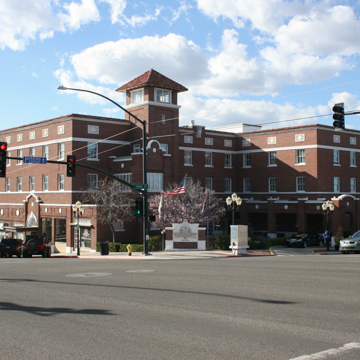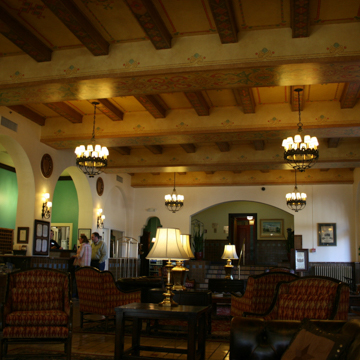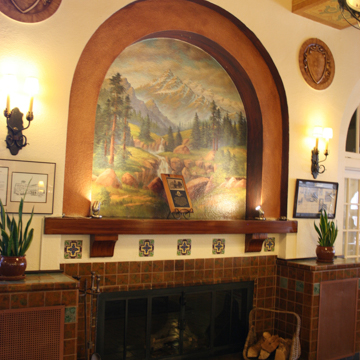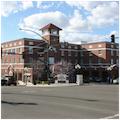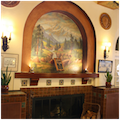You are here
Hassayampa Inn
The Hassayampa Inn is the local manifestation of a boom in Arizona hotel construction that occurred as the state developed its tourism economy during the 1920s, and a testament to the interrelated contemporary emergence of Prescott as a tourist destination. A work of the prolific Southwestern architectural firm Trost and Trost, the Hassayampa is notable architecturally for its adaptation to Prescott’s built environment, which, uniquely among Arizona cities, is strongly influenced by New England and the Midwest, and as an early example of a Southwestern hotel designed to accommodate automobile tourists.
Designed and constructed between 1925 and 1927, the Hassayampa (named for Prescott’s Hassayampa River) was the centerpiece of community boosters’ efforts to rejuvenate Prescott’s economy with tourism. Following its founding in 1864 as the capital of the Arizona Territory (a status it held until 1867 and again from 1877 to 1889) and the Yavapai County seat, Prescott prospered due to an economy centered on gold mining and cattle ranching, emerging as the political and economic center of the territory. By the end of the first decade of the twentieth century, however, the city could no longer claim this status. In addition to losing the territorial capital to Phoenix, the city endured a recession in 1907 from a downturn in mining activity and regional commerce. Although its economy soon stabilized, Prescott businessmen saw little hope for the city’s industrial growth and sought other economic means to revive prosperity. Tourism was the obvious answer. During the 1920s, when Prescott began taking an active interest in developing its tourist economy, Arizona was in the midst of a tourism boom. The state benefitted from transcontinental and California railroad connections, better roads, and the increasing popularity of the automobile, all of which made it more accessible to visitors. Prescott had a number of additional advantages: a mild climate, a central location in the state, and ample recreational opportunities.
Similar to other Arizona cities seeking to attract tourists during the 1920s, local boosters determined what Prescott needed was a modern hotel. Beginning in 1925, the Prescott Kiwanis Club led a public endeavor to obtain financing for the hotel project, campaigning successfully for subscriptions from the local citizenry, who became shareholders in the newly organized Hassayampa Hotel Company. The hotel company selected a site in the central business district at the northwest corner of Gurley and Marina streets, a block from the Courthouse Plaza and directly on U.S. 89, a major north-south highway.
By the mid-1920s, Trost and Trost of El Paso was firmly established as both the Southwest’s leading architectural firm and the region’s foremost hotel designers. Founded by Henry C. Trost and his brother Gustavus Adolphus Trost, the firm designed civic, commercial, educational, and residential buildings in a variety of modern and historicist architectural styles in Arizona, New Mexico, Texas, and northern Mexico during the early twentieth century, shaping much of the region’s architectural character in the process. Their work included many of the Southwest’s leading hotels, and the Hassayampa is an early example of the hotels they designed during the second half of the 1920s to accommodate the increasing number of tourists traveling the region by automobile. The firm received the Hassayampa commission partly on the basis of its design of the Franciscan Hotel (1920–1923; demolished) in Albuquerque, a similar community-funded hotel project that bolstered its city’s status as a tourist destination and attracted attention from the American and European architectural press on the basis of its modernist and Pueblo Revival design.
Accordingly, the initial, much larger, design for the new Prescott hotel drew heavily on its Albuquerque predecessor while incorporating new features for the convenience of motorists. The eight-story building would be a stylistic hybrid of Pueblo Revival and Art Deco, consisting of a picturesque two-story base embellished with balconies, a belfry, and a domed tower that supported, on the west side of the lot, a starkly rectilinear six-story high rise. To accommodate guests arriving by automobile, the first two stories were L-shaped in plan, hugging the rear of the lot to provide space for a curvilinear driveway leading to the main entry. Prescott citizens, however, felt the design was out of scale with the town and stylistically incompatible with its prevailing architecture, which reflects the Midwestern and New England origins of its earliest residents and largely eschews Southwestern architectural styles.
As built, the Hassayampa retains the original scheme’s automobile-oriented amenities but conforms to Prescott’s built environment. Trost and Trost discarded “Pueblo Deco” in favor of an eclectic blend of Renaissance Revival and Mission Revival, the latter style adapted to Prescott by being rendered in red brick rather than stucco. The three-story building is L-shaped in plan, with irregular massing and a flat roof with mission tile on the parapets. Following the original concept, the hotel is oriented away from downtown, with its main facade on Marina Street, facing east toward motorists arriving in town on U.S. 89. Each leg of the “L” hugs the rear of the lot, providing space for a garden entry court with a small fountain on the southeast corner and a curvilinear driveway off Marina Street. To accommodate automobile tourists, the latter leads to a brick porte-cochere that extends from the east facade and serves as the hotel’s main entrance. Set back behind the driveway and garden entry court, the hotel’s main facade is accented by an offset, four-story bell tower that rises above the main roofline and is topped by a pyramidal roof with mission tile. The south-facing Gurley Street frontage, which slopes sharply to the west, is set flush with the lot line and incorporates a series of storefronts and a hotel entrance oriented to downtown and pedestrians. Originally containing 80 rooms, the hotel’s public spaces included a lobby, coffee shop, dining room, and writing room. The spacious lobby has many of Trost and Trost’s signature decorative features, including tile floors and wainscoting, a hand-painted beamed ceiling, a fireplace, and large windows looking out into the garden courtyard and the surrounding streets.
The Hassayampa did its part to attract tourists to Prescott, serving as the city’s leading hotel and a popular gathering place for locals, tourists, and celebrities from its November 1927 opening into the 1950s. By the 1960s, however, the rerouting of U.S. 89 from Gurley Street and new motels on the city’s outskirts drew away business. In response, the hotel’s owners made plans to rebuild the structure as a mid-century modernist motel. This scheme remained unrealized, but talk of demolishing the hotel extended into the 1970s. In the mid-1980s, new owners hired Prescott architect Bill Otwell and the Phoenix architectural firm Allen and Philip to restore and update the hotel. In addition to adding a new heating and cooling system, reconfiguring the guest rooms to add private bathrooms, and incorporating fire safety features, the five-month renovation project restored a number of missing original features such as the fountain in the entry court and the painted decorative scheme in the lobby. Now operating as the Hassayampa Inn with 67 rooms, the hotel is a member of the National Trust for Historic Preservation’s Historic Hotels of America and remains a center of the Prescott community.
References
Brown, David M. “New Hotel Pledges Prescott’s Faith In Her Future.” Courier(Prescott, Arizona), November 23, 1992.
Clark, Victoria. How Arizona Sold its Sunshine: Historical Hotels of Arizona. Sedona, AZ: Blue Gourd Publishing, 2004.
Engelbrecht, Lloyd C., and June-Marie F. Engelbrecht. Henry C. Trost: Architect of the Southwest. El Paso, TX: El Paso Public Library Association, 1981.
Henry C. Trost Historical Organization. Accessed June 16, 2016. http://www.henrytrost.org/.
McCroskey, Mona Lange. “When Prescott Rallied To Build The Hassayampa.” Daily Courier(Prescott, Arizona), October 7, 2001.
“Progress Edition Dedicated To The Opening of The Hassayampa Hotel.” Prescott Evening Courier(Prescott, Arizona), November 19, 1927.
Ruffner, Melissa. Prescott: A Pictorial History. Prescott, AZ: Primrose Press, 1981.
“Trost Chosen As Architect Of New Hotel.” Prescott Evening Courier(Prescott, Arizona), September 23, 1925.
Woodward, Jim, “Hassayampa Hotel,” Yavapai County, Arizona. National Register of Historic Places Inventory–Nomination Form, 1979. National Park Service, U.S. Department of the Interior, Washington, D.C.
Writing Credits
If SAH Archipedia has been useful to you, please consider supporting it.
SAH Archipedia tells the story of the United States through its buildings, landscapes, and cities. This freely available resource empowers the public with authoritative knowledge that deepens their understanding and appreciation of the built environment. But the Society of Architectural Historians, which created SAH Archipedia with University of Virginia Press, needs your support to maintain the high-caliber research, writing, photography, cartography, editing, design, and programming that make SAH Archipedia a trusted online resource available to all who value the history of place, heritage tourism, and learning.














